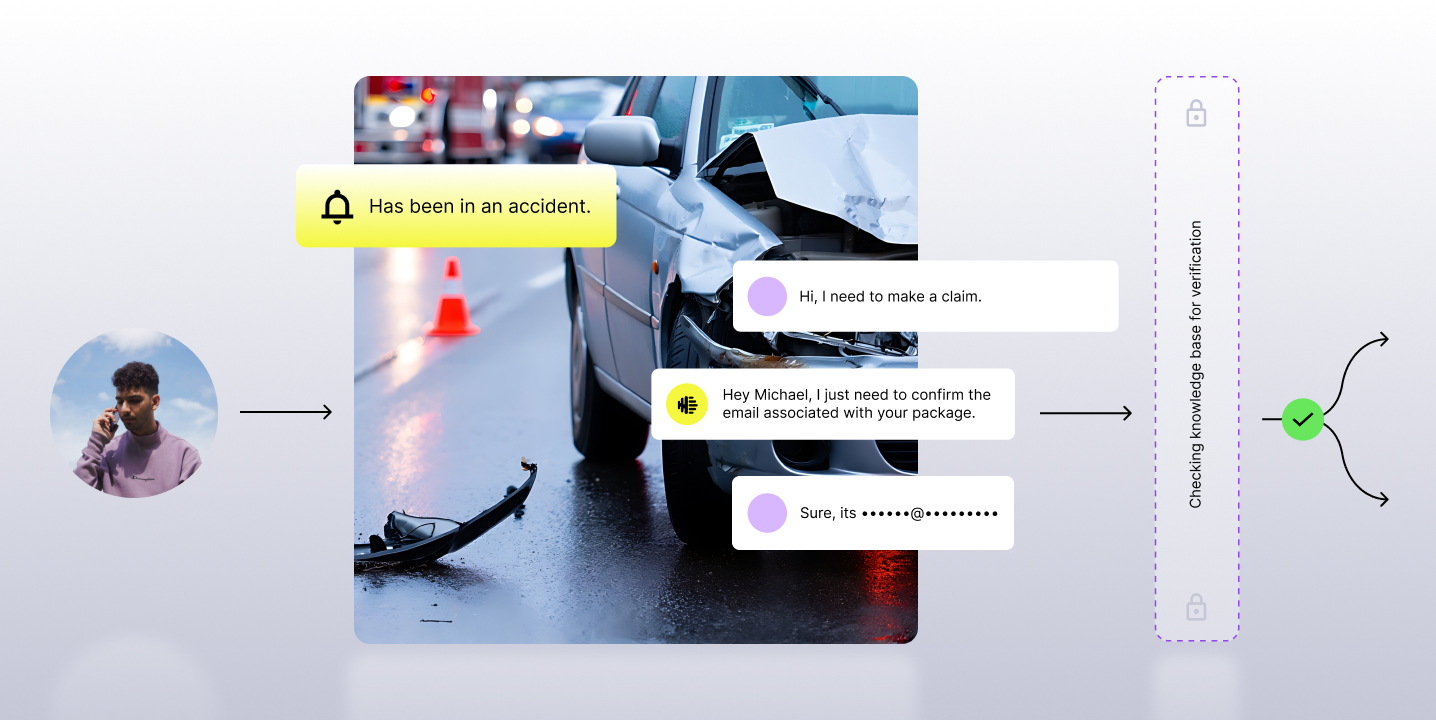Customer support agents walk a tightrope.
They deal with similar requests over and over, which means it’s easy to go on autopilot. At the same time, each customer interaction is a unique opportunity to create a connection with a customer and improve customer satisfaction.
Customer support scripts are an essential tool that help top customer support agents balance on that tightrope.
What is a customer support script?
A customer support script helps support agents provide quick and thorough resolutions to common customer issues, requests, or questions. They also help ensure agents are properly opening or closing calls, staying compliant with disclosures, or in highly-regulated industries, asking for necessary customer verification information.
Scripts can be used via any support channel, but they’re often known as macros or canned replies when delivered via text. Great customer service scripts ensure adherence to company policy, tee up correct answers, are full of brand-consistent positive language and reduce frustrating experiences.
Everyone has had an experience with bad support scripts. Poor scripts sound robotic, don’t fit the tone of the conversation, or include extra information that tip off customers to their templated nature.
Unfortunately, with the proliferation of AI tools in the customer experience space, there’s been a huge increase in inauthentic, tedious, and unhelpful customer communication.
Below, you’ll find a collection of human-first customer support scripts. Use these as a starting point to providing highly empathetic responses to your customers that help you stand out in a sea of inauthentic interactions!

Scripts for challenging conversations
Sometimes things just go wrong. Even in the most well-oiled companies and support operations, occasionally you’re going to create experiences that aren’t perfect.
But in a landscape where 61% of customers say they’d consider switching companies after just one bad customer service interaction, you can't afford to ignore the opportunity to repair and salvage those customer relationships!
These scripts will help you take a subpar interaction and transform it into a situation that builds trust and reinforces loyalty with your customers!
Dealing with unhappy customers
When to use it: Someone’s mad! If you’re a veteran in the customer support field, you’ll recognize this as a common occurrence. With or without reason, support teams consistently deal with upset customers.
The secret is that it doesn’t always matter why a customer is upset—what matters is how you choose to handle those frustrating experiences.
The script:
Hi there <customer’s first name>. First, I want to say that I hear you and I completely understand how this has been a frustrating situation. I am sorry for that – it’s absolutely not the experience we want you to have with us.
I’m going to help get this sorted out as quickly as we can. To help me do that, can I start by making sure I understand the problem?
It sounds like: <recap the customer’s issue in your words, sticking to the facts of the matter and ensuring you understand the full scope of their needs.>
Did I get that right? Is there anything else you would like to add? I don’t want to waste any of your time, and I appreciate you helping me by reviewing.
<Pause for confirmation or addition of details.>
<Lay out your next steps, make sure they’re actionable, and give deadlines or time expectations where possible. This is the promise you’re making to this customer.>
Thank you again for your patience with us!
Why it works: Most people want to feel heard. When interacting with an angry customer, the most important part is delivering on their need to feel heard. Acknowledge their frustration and poor experience, and then repeat back to them their needs to demonstrate understanding.
This becomes the pivot point in the interaction.
From there, you’re able to clearly lay out what you can do and when you’re going to have it done. Listening to your customer empathetically can earn you some good will. Don’t waste it by being wishy-washy on what comes next and when.
Earn that loyalty by following through!
We broke something
When to use it: Oops, you’ve goofed up. Somewhere, somehow wires were crossed and your company dropped the ball and created a mess for this customer.
The script:
Thank you so much for your patience and understanding, <customer first name.> Ultimately, what’s happened is that we’ve made a mistake. That’s totally on us, and I am very sorry that it’s impacted you like this.
Given that this is our fault I want to start with doing what I can to make this right.
<Lay out a meaningful gesture of goodwill to this customer. Even minor interruptions, caused by your team, can have an outsized impact. It’s better to be generous here.>
I know that this doesn’t undo what’s been done, but I wanted to make sure that we followed up on our apology with something concrete. In addition to this, I’ve worked with my team to identify where things went wrong and we’ve put together a plan to ensure that this doesn’t happen again.
I want to offer my sincere apologies one more time, and again thank you for your understanding of this situation. If there is anything else I can do, please do not hesitate to let me know.
Why it works: The secret to a good apology is owning what you’ve done wrong. So many companies are allergic to acknowledging fault, and instead choose to dig their heels in.
These faultless apologies are—at best—inauthentic. In reality, they often create customer experiences that feel demeaning or dismissive. This script guides you through taking ownership, making amends, and taking action to make things right – helping you create loyal customers even when you’ve made mistakes.
Demanding a refund
When to use it: A customer is over it and they’re ready to move on – with a refund in hand.
The script:
First, I’ve gone ahead and processed your refund for you. That should appear in <details on when and where they’ll see the refund>. I’m very sorry that we didn’t live up to the experience you expected, and we wouldn’t want to keep you money when we haven’t delivered what you’re after.
That said, I would still love to see if there’s more we can do to help you out. To that end, I’ve gone ahead and placed you on a free trial for the next week (or other gesture of goodwill that aligns with your company policy).
If you’re up for it, I’d be happy to schedule some time to hop on a screen share and work together on this or to dive into some of the questions you’ve had. I would also totally understand if that’s not something you feel up to right now!
That’s a standing offer, and you’d be welcome to take me up on that at any point. If you’ll give us a chance, I’m confident we can get things working well for you.
Why it works: Nothing is more disarming to someone who has been trained to believe they have to fight for a refund than giving it right to them, no hurt feelings or tricks involved. This one move calmly redirects their energy and dissolves any anger or defensiveness. (My dad calls these efforts emotional jiu-jitsu. He probably shouldn’t.)
With your refund olive branch in hand, your customer is much more amenable to being guided back to the value your tool brings. Even if they don’t take you up on that, instead of leaving this experience on a sour note where they’ve had to fight for a refund, they’ll walk away with a positive experience that makes them much more likely to return!
You cost too much
When to use it: A customer is certain it just can’t possibly cost this much to run your service or make your product and they don’t believe anyone is paying for it.
The script:
Thank you so much for reaching out and for taking the time to share your feedback on our pricing, <customer first name.> I totally understand – making sure that I’m spending my money as wisely as possible, and receiving real value out of what I buy, is important to me too.
We take your feedback very seriously and we’re always iterating on our pricing.
There are a lot of competing demands for your money, and some of our competitors might offer a lower price point than us. I would definitely encourage you to explore those options if you feel like they meet your needs.
That said, we believe that our <tool/service/good> provides unique value to our customers. In particular, we believe that <list two or three of the key strengths or differentiators of your goods to highlight> go above and beyond what our competitors offer.
I would be happy to set you up with a free trial and answer any questions you might have about the product to make sure you’ve had the opportunity to see firsthand why we think it’s the best option out there.
Why it works: You should be confident in your product and what it has to offer to your customers. This script demonstrates that you believe in that value proposition and offers to lead your skeptical customer through that experience first hand. It creates a memorable experience where, when a competitor isn’t able to deliver what this customer’s needs, this customer will want to return!
Scripts to ask for more
Whether it’s a ticket asking for an update on a purchase or a nagging certainty that a client needs to go ahead and give that power button a press again, support teams often have to make asks of their customers.
Using the right language can turn even the most ornery and obstinate customers into folks who’ll happily help you out!
Try that again
When to use it: Sometimes you really need to have a customer repeat that step, even though they’ve already done it. You know it has to happen, but they might feel like they're stuck in Groundhog Day clicking the same button for eternity.
Use this customer service script to guide your customers out of these time loops and into your good graces.
The script:
Awesome! We’re closing in on a solution for this one, <customer name>. Thank you for all your help as we’ve worked through this. I’ve got one more step for us to try that’ll help move things forward.
<clear, bulleted instructions or the steps needed to complete this. Support this with a .gif or screenshots where possible.>
Can you give that a shot for me? If that doesn’t solve things, can you walk me through exactly what happens?
Why it works: With this script, you’re communicating to your customer that you’re in this thing together—and that hopefully you’re nearing the end! Creating a shared sense of ownership and success helps keep customers engaged with solutions—even if they’ve tried them before.
Asking for detailed steps if things still aren’t solved is another important trick to help customer support agents identify gaps in their instructions or highlight unclear requests.
Mind leaving a review?
When to use it: You’ve had a great customer interaction and you want to capture their sentiment in a review or survey—without spoiling the mood.
The script:
I’m so glad we were able to help you out with this! It was a pleasure working through this with you.
We’re always keen to improve our customer service experience to ensure we’re helping folks like you to the best of our ability. If you have any feedback you’d like to offer, we’re all ears! You can share that with us here: <link to survey or review form>.
Why it works: We’re not burying the lede here: We want their feedback and we’re asking for it clearly. When your customer service agents give great support, it’s the perfect time to ask you customers to share their opinion of it.
Beating around the bush or making a soft ask for feedback can be counterproductive. Just remember that when you ask for a review or feedback, it’s important to be explicit that you’re open to hearing about ways you can improve–not just seeking compliments.

Gain data-backed insights on your customer experience
Knowing whether or not your customer service team is hitting the mark can be challenging. Customer support scripts are a key way to equip support agents to build rapport even during difficult conversations—but it’s just a start.
Observe.AI can help you unlock hidden insights in your customer conversations with contact center conversation intelligence. By analyzing every customer conversation, you’ll get real-time guidance to improve your customer experience across every touchpoint.
Schedule a demo today to learn more about how better conversation intelligence and insights can supercharge your customer service team.


.png)














